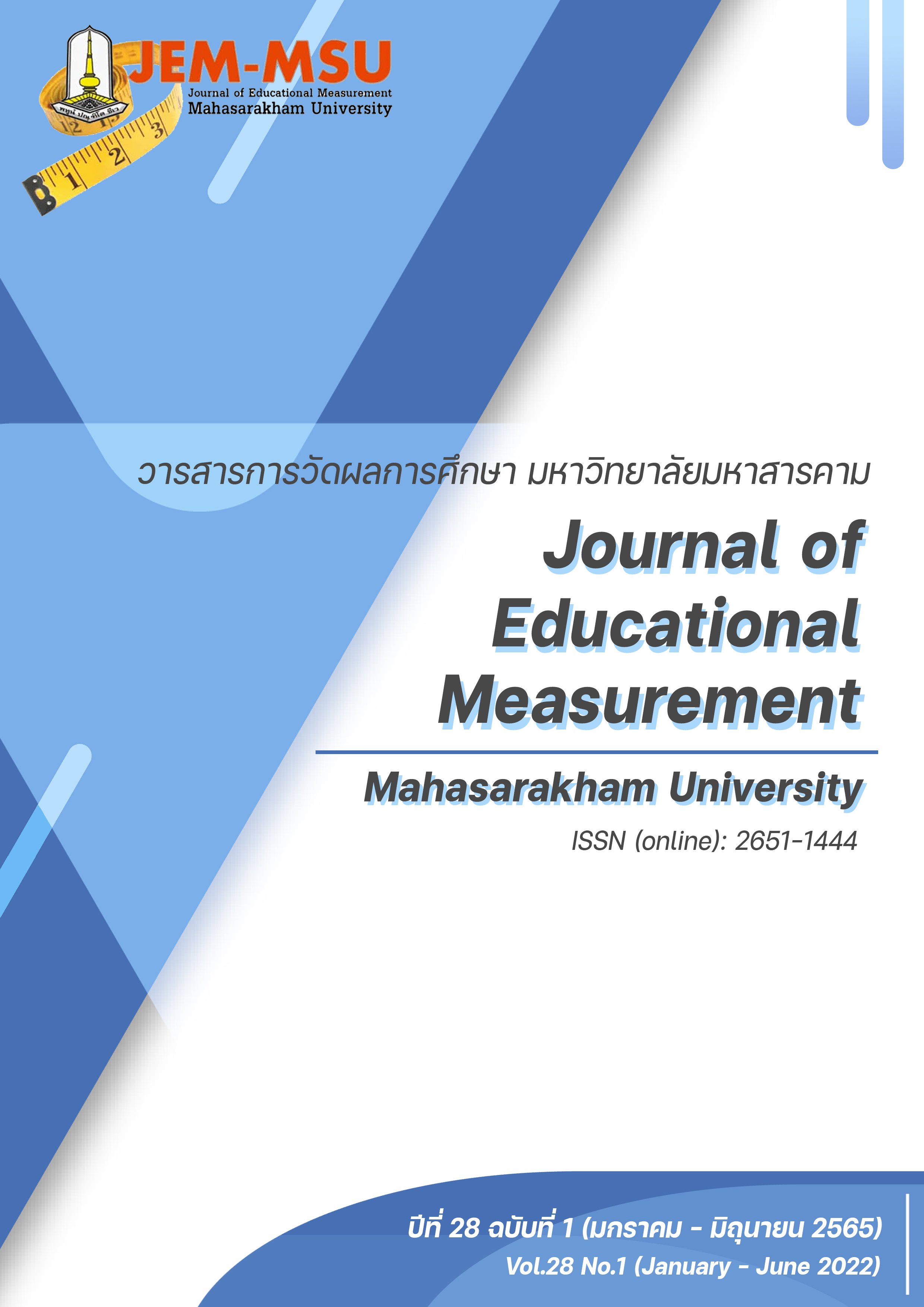Effects of the Social Desirability Responses on Quality of The Social Responsibility Test for Grade 7 Students
Main Article Content
Abstract
This research aimed to 1) develop and verify the quality of a social responsibility test of grade 7 students, 2) investigate the responses to the social responsibility test of the test takers who responded to the social desirability form differently, and 3) compare social responsibility test results to find the quality of the test that the researcher has developed, before and after grade 7 students responded to the social desirability. The participants were 787 grade 7 students under the Office of Secondary Education Service Area 25 in the academic year 2020, obtained through multistage sampling. The research instruments were 1) a social responsibility test developed by the researcher for grade 7 students. It was a situational test with 33 items, and 2) a secondary school students' characteristics test: a social desirability responding by AREASIG Research Group, Khon Kaen University. It was a rating scale questionnaire with 35 items. In developing this social responsibility test, the quality of the test was checked by using analyses, basing on the Classical Test Theory (CTT), as follows: 1) the content validity was considered by experts, 2) the construct validity was analyzed with confirmatory factor analysis: CFA, 3) the discrimination was analyzed with Item-total Correlation, the reliability was analyzed with Cronbach’s Alpha method, and the quality was verified with the Item Response Theory (IRT). The research findings were as follows:
1) The social responsibility test for grade 7 students consisted of 4 components: responsibility for family, responsibility for friends, responsibility for school, and responsibility for community. The quality according to experts’ judgment showed that CVR value was 1.00. The confirmatory factor analysis showed that the results from the students' social responsibility test were consistent with the chi-square of 38.727, df of 29, P-Value of 0.1070, RMSEA of 0.035, SRMR of 0.021, CFI of 0.995, and TLI of 0.991. The discrimination values were between 0.238 and 0.653 and had a significant relationship at the .01 level. The Cronbach's alpha coefficient = 0.947. The Item Response Theory (IRT) had the slope parameter (i) of all the items from 0.30 to 1.96, and the threshold parameter (
ij) of each item had an ascending order of values.
2) The results of the social responsibility test, which were classified according to the test taker groups that responded to the social desirability differently, could be divided into 5 groups (SDR1-SDR5). It was found that the group with the highest average scores of the social responsibility was the SDR5, with the score of 82.74. On the other hand, the group with the lowest average score of the social responsibility was the SDR1, with the score of 71.98. When comparing the differences in responses among the five groups by One-way ANOVA analysis, it was found that they were significantly different at the .01 level.
3) The comparison of the quality of the social responsibility test, devised by the researcher, for grade 7 students between before and after grouping students with socially desirable response scores from the socially desirable responding test which was based on the Classical Test Theory (CTT) revealed that the discriminations before SDR grouping varied from 0.227 to 0.584, and from 0.305 to 0.611 after SDR grouping, The Cronbach's alpha reliability was = 0.865 before grouping and = 0.861 after grouping, respectively. In terms of quality according to the Item Response Theory, the common slope parameter (αi) which was higher than 0.65, was seen in 27 items before grouping, and in 28 items after grouping, and regarding the threshold parameter values (i),
1 and
2 distributed towards both positive and negative sides in 7 items before grouping and in 8 items after grouping. However, all questions in the social desirability responding, both before and after grouping, had ascending
1 and
2 values.
Article Details

This work is licensed under a Creative Commons Attribution-NonCommercial-NoDerivatives 4.0 International License.
The content and information contained in the published article in the Journal of Educational Measurement Mahasarakham University represent the opinions and responsibilities of the authors directly. The editorial board of the journal is not necessarily in agreement with or responsible for any of the content.
The articles, data, content, images, etc. that have been published in the Journal of Educational Measurement Mahasarakham University are copyrighted by the journal. If any individual or organization wishes to reproduce or perform any actions involving the entirety or any part of the content, they must obtain written permission from the Journal of Educational Measurement Mahasarakham University.
References
Hinkle, D. E., Wiersma, W., & Jurs, S. G. (1998). Applied Statistics for Behavioral Sciences (4th ed.). Rand McNally College Publishing.
Arunmala, P. (2019). The Effects of Using a Virtue Ethics Scale with Socially Desirable Responding Scale of Lower Secondary School Students [Master’s Thesis]. Khon Kaen University. (in Thai)
Juntawarn, S. (2013). Development of a Socially Desirable Responding Scale of Thai Undergraduate Students [Doctoral dissertation]. Chulalongkorn University Intellectual Repository. http://cuir.car.chula.ac.th/handle/123456789/43653. (in Thai)
Kanjanawasee, S. (2013). Classical Test Theory (7th ed.). Chulalongkorn University Press. (in Thai)
Nathomthong, W. (2013). The development of Thai language achievement test for grade 10 accordance to core basic education B.E. 2551. [Master’s Thesis]. Silpakorn University. (in Thai)
Sangsin, S. (2008). Roles of Family and Educational Institution in Developingment Students’ s Social Responsibility Behaviors [Master’s Thesis]. Khon Kaen University. (in Thai)
Sirivunnabood, P. (2010). Developmental Psychology Theory (5th ed.). Chulalongkorn University Press. (in Thai)
Srichom, P. (2014). Comparison of Effects of Measurement Methods on Mental Health Scale Derived from Social Desirability Responses: An Application of CEUL and CEML [Master’s Thesis]. Chulalongkorn University. (in Thai)
Srisuk, K. (2009). Research Methodology (3th ed.). Krongchang Printing. (in Thai)
Sukonthabopit, S. (2019). World’s Mission for NOW. https://www.creativethailand.org/new/article/trend/32257/en#Worlds-Mission-for-NOW
Wiratchai, N. (1999). LISREL Model: Analytical Statistics for Research (3rd ed.). Chulalongkorn University Press. (in Thai)
Wora-in, C. (2011). Development measurement and evaluation test. http://elearning.psru.ac.th


